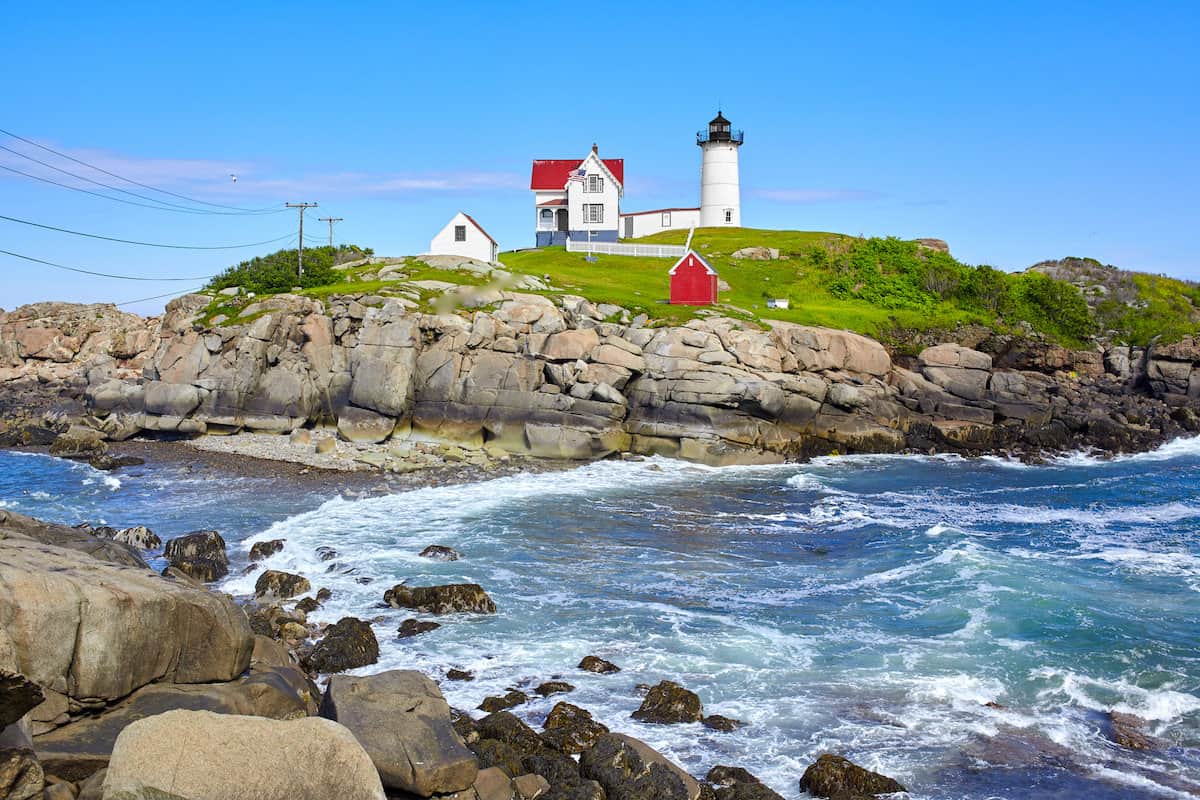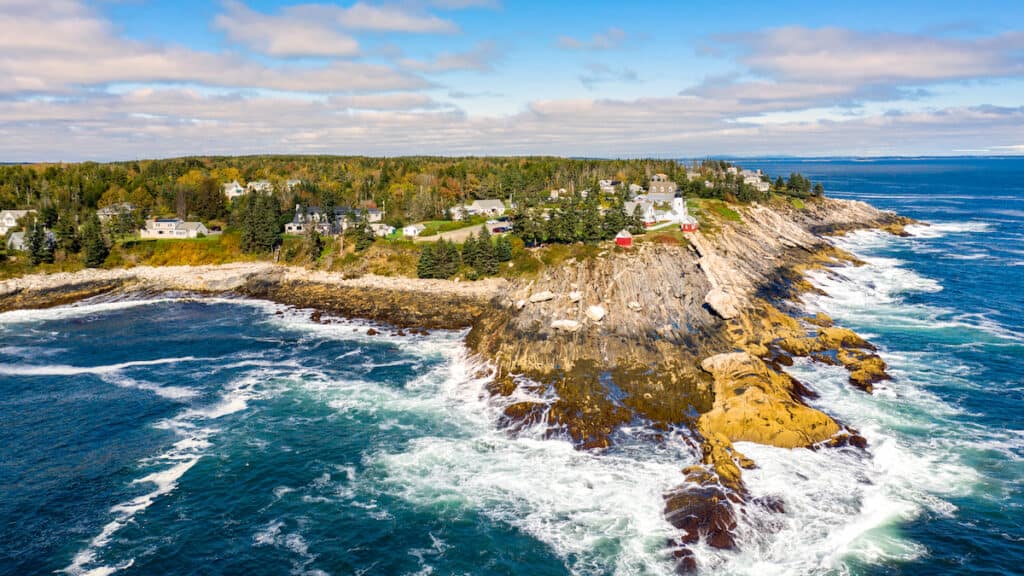Maine’s picturesque coastline offers some of the top striper fishing in the Northeast.
Whether you’re timing your trip to meet these fish as they first arrive in May and June or plan to catch them as they gather to make their way south toward the Mid-Atlantic in September and October, Maine can be an incredible place to chase striped bass.
Maine Striper Fishing: Timing the Run
While seasonal variation will inevitably impact the migration every spring and fall, check the tide tables to help you time your Maine striped bass fishing trip.
Planning your trip close to a full or new moon cycle will have you fishing during the strongest tides.
Larger exchanges between low and high tides add to the volume of moving water and tends to concentrate more baitfish, giving stripers a greater advantage over their prey. It also makes the stripers’ movements more predictable for anglers.
Migrating stripers might pass by any Maine beach for a long stretch of the warmer season. The months of June and July and then again from September into October tend to be peak fishing times.
We’ll provide some bait and lure tips specific to some of our top locations, but for a full how-to guide for catching in stripers in the surf, see our the link near the bottom of this article.
Now that you know when to catch Maine stripers, we recommend the following spots for your best shot at connecting with fish on the move.
Where to Catch Maine Stripers
Now we’ll start at the southern end of Maine and end within sight of Canada.
York Beach/Nubble Lighthouse
Just over the border from New Hampshire, York Beach and Nubble Lighthouse are the beginning of Maine’s rocky striper coast.
A small island just off the shore and the channel between it and the mainland can be striper-holding structure and are a good bet for southern-Maine anglers.
The channel between Cape Neddick Nubble (the island with Nubble Lighthouse) and the mainland can concentrate fish. This is a favorite striper angler location, especially in June and again in September and early October.
Like many Maine coastal beaches, it is mostly rock, so take care while wading or walking near the water.
Swimming plugs like Bomber Long-A’s and soft-plastic baits like Tsunami Storm Shads can both be effective when fished in the channel in the hours surrounding high tide.
Nubble Light is a fairly famous Northeast landmark worth visiting in its own right.
Access: Sohier Park is right across from the island holding Nubble Lighthouse. There is public parking and fishing.
Colony Beach in Kennebunkport
Kennebunkport often made the news because President George H.W. Bush had a summer home about a mile from Colony Beach. Both Kennebunk Beach and the adjacent Colony Beach can play host to stripers on the move in May, June, September and October.
The stretch of beach between the Kennebunk River and Cape Arundel has the deepest water within casting distance of shore. This area should be your first target if you’re fishing at Colony Beach.
Access: The good news is that there’s no parking pass required for Colony Beach. The bad news is that makes it a first-come-first-served situation.
Hills Beach
Hills Beach, at the mouth of the Saco River in Biddeford, can be a productive surf fishing location in spring and fall.
Saco Bay, which sits between Wood Island and Cape Elizabeth State Park, offers a calmer, shallower cove where stripers can ambush baitfish like sand eels and peanut bunker (juvenile Atlantic menhaden) as they continue along their migratory route.
Hills Beach sits right on the southern end of the bay, where Wood, Stage and Basket islands provide these fish ambush points and current breaks they’ll use to their advantage.
Access: There is street parking on Hills Beach Road.
Old Orchard Beach
Between Biddeford Pool and Prout’s Neck, Old Orchard Beach sits right on Saco Bay. It is a favorite destination for tourists visiting Maine and also just a half hour from Portland.
But the protected cove and the nearby Nonesuch River also make this a magnet for all manner of ocean life. Striped bass are no exception.
Right where Goosefare Brook flows into the Atlantic, and particularly just to the north around Ocean Park, you’ve got a stretch of beach with a relatively steep drop near the shore.
Striped bass will use this kind of location to pin baitfish where they can’t escape. Fresh or frozen mackerel, bucktails or diamond jigs can all be effective at Old Orchard.
Access: Old Orchard Street has metered parking, and during the summer you can buy parking permits for municipal lots here.
Scarborough Beach State Park
The Scarborough Beach State Park sits right where the Nonesuch River flows into Saco Bay, and it can be teeming with life in the spring and fall. The beach, and the state park land it is on, creates a sheltered cove along the coast.
That cove often holds smaller baitfish like sand eels, which will bring the stripers in en masse.
Focus your efforts on the protected water here, where stripers will be holding out of the wind and current while looking for baitfish doing the same.
Access: For information about seasonal parking passes and locations, visit the Scarborough Beach State Park site.
Harpswell Island
Just south of Brunswick, there are a series of interconnected islands that stretch out into Casco Bay like fingers reaching out to touch the myriad of species migrating by.
Harpswell Island and the adjacent Orr’s and Sebascodegan islands extend into an environment of flats rich with life ranging from crabs to sand eels to the schools of stripers chasing them.
The shallower-water flats environment here makes for ideal light-tackle fishing, and the location is a favorite among fly-rodders.
Soft-plastic baits like Hogys and jointed Rebels will work well for the spinning set and big streamers are fly-fishing favorites.
Access: Robin Hood Road on Bailey Island will bring you to nearby Cedar Beach Public Parking.
Popham Beach State Park
Popham Beach State Park in the town of Popham Beach has long been a favorite location for surf anglers chasing stripers.
Both the Morse and the Kennebunk rivers empty into Casco Bay here, and a host of islands provide ample structure to hold the baitfish that stripers chase down the coast.
You’ve got a combination of both rocky jetties and soft sand beaches here, so if you’d rather stick a sand spike in the surf and soak a chunk of mackerel, you can relax, but if you’d prefer throwing bucktails or diamond jigs, climb on a jetty and give it a shot.
Popham Beach is a particularly popular spot for striper fishing, so expect some company on this beautiful shoreline.
Because of large variations in tide height, plan your trip between one and two hours before high tide.
Access: Popham Beach State Park off Rte. 209 offers public parking, restrooms and picnic tables.
Mile Beach (Reid State Park)
Mile Beach in Reid State Park is at the mouth of the Sheepscot River.
This is just to the north of Popham Beach State Park (above) but the mouth of the Sheepscot and the Little River make it a nutrient-rich stretch of the coastline with great access for surf fishing.
Todd’s Point is a sandy stretch of beach that fronts the runs along where the Little River flows out to the Atlantic. It is definitely worth a visit in the spring.
Small, near-shore islands and plentiful rocks provide structures that will hold baitfish near the beach, and where there are baitfish, stripers are seldom far behind.
The combination of river mouths and structure like Little River Ledges and Outer Head Island make this ideal striped bass habitat.
Access: Reid State Park at the south end of Seguinland Road in Georgetown offers ample public parking during daylight hours.
Pemaquid Point Light
At Pemaquid Point, a long finger of land reaches south into the Atlantic from the Maine coast at Bristol, forcing stripers to navigate around as they move north or south.
Any time you have these points (think of the famous Montauk Point and Cape Cod) that jut into what would otherwise be the main striper highway along the coast, fish will concentrate as they round the tip.
If you can time your trip right, you stand a chance at excellent striper fishing at points, and Pemaquid Point is no exception. Muscongus Bay to the north and west of the point attracts and holds bait every spring and can also be a promising point to intercept the exodus in the fall.
While visiting the lighthouse is a seasonal option (May through October) that costs money, parking there is free. There’s also a fisherman’s museum at Pemaquid Point, although the hours there are also seasonal.
Access: Pemaquid Point Lighthouse parking is south at the end of Bristol Road.
Birch Point State Park
Farther north near Owls Head, you’ve got another state park that offers anglers solid shots at promising striper water.
The Weskeag River is a striper favorite in the spring, and these fish will be pouring back by as water temperatures drop in early autumn.
The Weskeag flows into the Atlantic near Birch Point State Park. As with many Maine surf fishing locations, you’ve got nearby islands. In this case, Spaulding Island can be bait-holding structure that’s almost within casting distance.
Spaulding and other nearby islands give promise, especially for surfcasters looking for those larger fish coming in after sunset.
Access: Ballyhac Road leads to the Birch Point Beach parking lot.
Fort Point State Park
Where the Penobscot River empties into Penobscot Bay, Fort Point State Park offers public access for anglers, kayakers and boaters.
The Penobscot can be a tremendous striper fishery in the spring when these fish are heading into rivers. Then in the fall, stripers take advantage of the concentrated bait and added structure from islands in this bay as they move south.
Because you’re a little bit farther up the Maine coast at Fort Point, you can look for fish to start schooling and feeding here as early as mid-September in the fall as they begin their push south.
Deer Island and Little Deer Island can both hold bait and fish. If you’re fishing from a boat, keep close watch on fluctuating tides and abundant rocks.
Access: There is free parking near Fort Point State Park Lighthouse during daylight hours.
Cobscook Bay State Park
There aren’t many striper beaches where you can see another country while casting, but Cobscook, just on the southern side of the U.S./Canada border, is one of them.
Cobscook, Denny’s and South bays are all protected coves that will draw bait like sand eels and the schools of stripers chasing them as water temperatures drop and these fish gorge.
The tides are particularly strong in this area and can swing as much as 24 feet in one tide cycle.
Also, you’re liable to see bears, eagles and ospreys along the shoreline. The forested terrain will definitely have a different feel from striper beaches to the south.
Access: Park/Burnt Cove Road has public parking, and you can find more park details here.
Catch More Stripers
Be sure to learn more about how to catch stripers from the beach with our resident surfcasting expert’s striped bass shore fishing techniques and tips.
Summary
While beaches in states to the south like New York, New Jersey and Rhode Island might see more consistent catches of large stripers from the surf, Maine offers some fantastic opportunities with less of a crowd and a scenic backdrop that’s tough to top.


